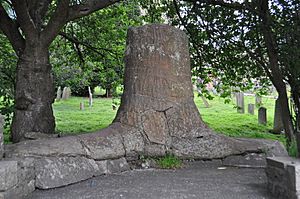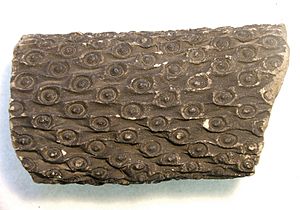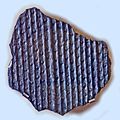Sigillaria facts for kids

Sigillaria was a type of ancient tree that lived a very long time ago, during the late Carboniferous period and early Permian period. These trees were part of a group called lycopods, which are early land plants. They looked a lot like another ancient tree called Lepidodendron.
Sigillaria trees grew in swampy forests, often called coal forests, because their remains later turned into coal. These amazing trees could grow very tall, sometimes up to 50 meters (about 164 feet)! They had a strong root system that spread out underground to keep them steady.
The leaves of Sigillaria were thin and looked a bit like grass. They grew directly on the stem, which was green. Sigillaria reproduced using spores, which are tiny reproductive cells, similar to how ferns reproduce today. Sadly, these trees died out about 300 million years ago.
Contents
What Was Sigillaria?
Sigillaria was a type of lycopod, which means it was a very old kind of plant that grew on land. It was one of the main trees that formed the huge forests during the Carboniferous period. These forests were so dense that when the trees died and were buried, they slowly turned into the coal we use today.
How Did Sigillaria Grow?
Sigillaria trees had a unique way of growing. Their stems were covered in a pattern that looked like scales or scars. These marks were left behind by old leaves that had fallen off. The stem was green, which means it could make its own food using sunlight, just like modern plants.
Sigillaria's Reproduction and Life Cycle
Instead of seeds, Sigillaria trees reproduced with spores. Spores are like tiny dust-like particles that can grow into new plants when they land in the right conditions. This was a common way for early land plants to reproduce before plants with seeds became widespread.
Where Can We Find Sigillaria Fossils?
Today, we can't see living Sigillaria trees, but we can find their fossils. These fossils are often found in places where coal was formed, like old coal mines. Scientists study these fossils to learn about what Earth was like millions of years ago and how plants have changed over time.
Images for kids
-
Sigillaria on display at State Museum of Pennsylvania, from Sharon, Mercer County, Pennsylvania
-
Sigillaria (bark) on display at State Museum of Pennsylvania, from Scranton, Lackawanna County, Pennsylvania
-
In situ Lycopsid that is probably Sigillaria from the Pennsylvanian Joggins Formation in Nova Scotia
See also
 In Spanish: Sigillaria para niños
In Spanish: Sigillaria para niños








